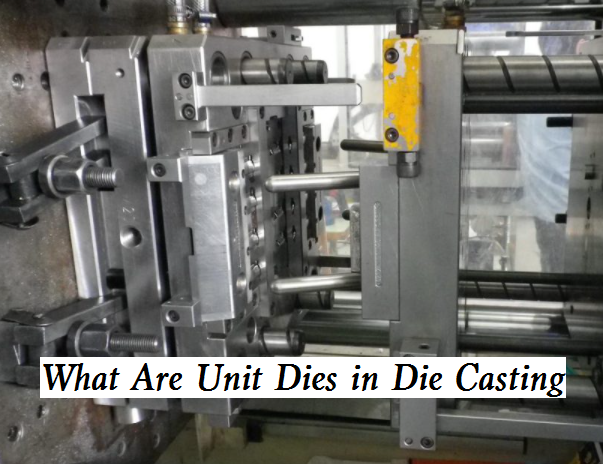Unit dies in die casting are tools that are used to cast products. How do unit dies work and what are they used for? Today we’ll get into an overview of unit dies.

What Are Unit Dies in Die Casting?
Unit dies in die casting refers to pre-manufactured dies that can be used to cast multiple parts with minor modifications. These dies are designed to be versatile and are typically available in a range of sizes and configurations, allowing them to be used for a variety of part designs.
Unit dies are typically made from high-quality tool steel and are designed to be durable and long-lasting. They are also designed to be easily interchangeable, which makes them ideal for use in high-volume production runs. Unit dies can be used to produce a wide range of parts, including those with complex geometries, and they can be used for both hot-chamber and cold-chamber die-casting processes.
Advantages of Unit Dies
Unit dies can significantly reduce the lead time and cost of tooling. Since unit dies are pre-manufactured, they can be delivered quickly and at a lower cost than custom-designed dies. Additionally, because unit dies are designed to be versatile, they can be used for multiple projects, which further reduces the cost and lead time of tooling.
How Does a Unit Die Work?
A unit die is a pre-manufactured die that can be used to cast multiple parts with minor modifications. A unit die works by injecting molten metal into a pre-manufactured die cavity to produce multiple parts with minor modifications. It is designed to be versatile and cost-effective, making it ideal for high-volume production runs. During the process, the die is mounted in the die casting machine and clamped shut. Molten metal is injected into the die under high pressure. The metal solidifies within the die, taking on the shape of the die cavity. The die is opened, and the part is ejected from the die. The process is repeated to produce additional parts.
Applications of Unit Dies
– Automotive Parts: Unit dies can be used to produce a range of automotive parts, such as engine components, transmission parts, and suspension components. Since the automotive industry requires high-volume production runs, unit dies are often used to reduce the cost and lead time of tooling.
– Consumer Goods: Unit dies can be used to produce a variety of consumer goods, such as kitchen appliances, toys, and sporting equipment. Unit dies are ideal for producing consumer goods because they can accommodate a range of part designs and can be quickly and easily modified for new designs.
– Electronics: Unit dies can be used to produce a variety of electronic components, such as computer parts, phone parts, and audio equipment. The electronics industry requires high precision and tight tolerances, and unit dies can be designed to meet these requirements.
– Industrial Equipment: Unit dies can be used to produce a range of industrial equipment components, such as hydraulic and pneumatic components, machine parts, and tools. Unit dies are ideal for producing these parts because they can be quickly and easily modified to accommodate different designs and can be used for high-volume production runs.
When to Use Unit Die in Die Casting
– If the production volume is high, a unit die can significantly reduce the lead time and cost of tooling. Since unit dies are pre-manufactured, they can be quickly delivered and used for multiple projects, which further reduces the cost and lead time of tooling.
– If the part design is not too complex, a unit die may be a suitable option. Unit dies are designed to be versatile and can be used for a range of part designs with minor modifications.
– If tight tolerances and high surface finishes are required, a custom-designed die may be a better option. While unit dies can produce high-quality parts, custom-designed dies can be more precise and offer greater control over the casting process.
– If cost and lead time are important factors, a unit die may be the best option. Unit dies are typically more cost-effective and have a shorter lead time than custom-designed dies.
Components of Unit Dies
– Die Plate: This is the main structural component of the die and provides the base for the cavity and the ejector system.
– Cavity Plate: This plate contains the cavity that defines the shape of the part being cast. The cavity plate is typically made from high-quality tool steel and is designed to withstand the high pressures and temperatures of the die casting process.
– Ejector Plate: This plate contains the ejector pins that push the part out of the cavity after the casting process is complete. The ejector plate is also typically made from high-quality tool steel.
– Guide Pins and Bushings: These components are used to align the die plates and ensure proper alignment of the cavity and ejector plates.
– Sprue Bushing: This component is used to direct the flow of molten metal into the cavity. The sprue bushing is typically made from hardened steel and is designed to withstand the high temperatures and pressures of the die casting process.
– Cooling Lines: These lines are used to circulate water or other cooling fluids through the die to maintain the appropriate temperature during the casting process.
– Venting System: This system is used to allow air and other gases to escape from the die during the casting process, which can improve the quality of the final part.

